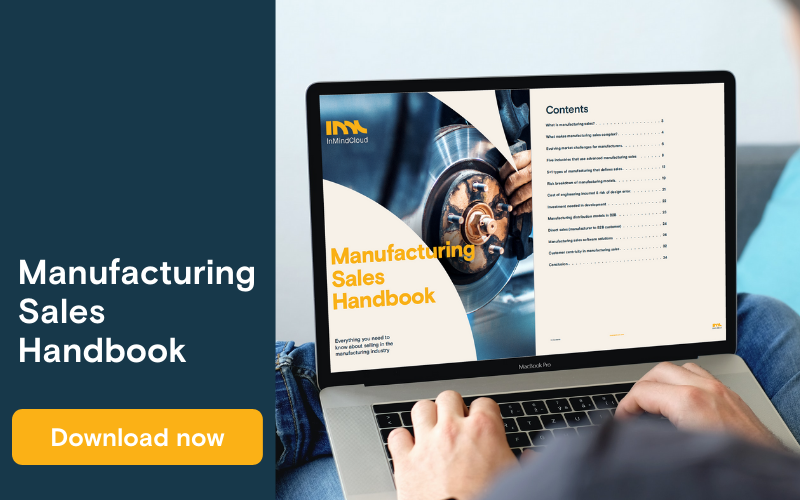Enterprises, not just in the manufacturing sector, are shifting to the cloud. The promise of lower overheads, seamless access, better security, agility, and flexibility is an attractive proposition. The problem? Cloud adoption is easier said than done.
Cloud is attractive, but is it easy?
From our perspective, we see many manufacturers facing difficulties with:
- Long implementation times
- High total-cost-of-ownership
- Achieving good return-on-investment
These are high barriers that large manufacturers can overcome eventually. But for smaller, mid-market manufacturers, it’s a struggle that can cause their digital initiatives to fail. In our recent webinar, experts from G2—a leading business software review site—shared some interesting statistics.
Manufacturers are investing heavily in digitalizing their sales process, specifically in CPQ, CRM, and Commerce. However, many of them are not seeing the business results they expect, such as cost savings or improved productivity.
Do you understand your manufacturing sales process enough to transform it? Download our new Manufacturing Sales Handbook to understand where and how digital can improve your sales process--and the entire business.
Let business needs drive transformation
So what are manufacturers getting wrong? A successful digital transformation initiative is driven by business needs. If your digital initiatives are not aligned with the business, getting it to produce the results you want becomes much harder. Here are our top 3 recommendations on how you can get it right from the start.
Recommendation 1: Adopt solutions built for your business
Today, manufacturers are approaching digitalization through general-purpose solutions. These solutions may be best-of-breed, but force-fitting them into your manufacturing business processes will result in a costly and lengthy implementation project that involves system integrators, middleware, and countless consultant hours.
Or you completely miss out on the needle-moving features, or functionalities your business needs. What we have just described is a problematic scenario observed 15 years ago with first-generation on-premise CRM systems or custom-built tools. And we see it again with general-purpose cloud-based systems.
Getting technology built for your industry and business model is essential. Your organization’s transformation journey is different from those in other sectors. Manufacturers have specific requirements that only solutions with highly specialized feature sets can fulfill.
The cloud software-as-a-service (SaaS) systems that you adopt MUST acknowledge and handle the fact that your business needs to connect its complex products, solutions, processes, and data to the backend. Cloud platforms that work well for retail, for example, cannot handle this level of complexity without extensive (and thus expensive) customization or connector/middleware.
Recommendation 2: Ensure minimum viable product capabilities
Our second recommendation is closely related to the first one. Adopting a solution built for your industry always ensures you get minimum viable product capabilities. Without a purpose-driven solution, your digital initiative costs could spiral out of control—or, worse, fail to achieve desired TCO outcomes.
That’s because your manufacturing business is incredibly complex - product variants and configurations can count in the billions. That is something your manufacturing-focused digital sales solution can handle through extensive product variants, costing, pricing and quoting functionalities.
In B2B manufacturing, your pricing and order management can also get extremely complicated. It can come in numerous variants, from 100% self-serve to 100% sales supported—and everything in between. It really depends on what your sales focus is on.
Regardless, key components like your CRM, CPQ, and E-Commerce should work seamlessly with each other. And, more importantly, be tightly integrated with your back-office ERP and manufacturing systems. This approach equips your sales team with the most accurate product information (costs, prices, margins, etc.) in real-time.
Recommendation 3: Establish a smooth customer & product experience
This final recommendation sounds simple. However, in our experience, you can only achieve it with a cloud-native platform. Solutions built in the cloud are modular, extensible, and can bring together data and processes from different applications in a loosely coupled but tightly integrated fashion.
Cloud-native platforms let you start fast and scale just as quickly. When implemented well, it allows your business to achieve a spectacular outcome that even larger enterprises struggle to deliver—an integrated offline and online customer experience. That means delighting your customer at every touchpoint from start to the end of the transaction - and possibly beyond.
Conclusion: Choose your digital sales tools wisely
The path to digital success in sales is a long and arduous one. There are other considerations that you must make along the way. But with these three considerations, you can lay the foundation for a robust transformation strategy and stay agile enough to adapt to any situation.
If there is only one thing you remember, it has to be this: Digital transformation is not about adopting digital solutions at the lowest prices or from the biggest brands and being promised it fits.
What is guaranteed to work is a digital platform built with your complexities and challenges in mind. This platform needs to understand manufacturing sales' uniqueness and have your industry’s best practices embedded in its DNA.
Do you know how digital solutions can improve your manufacturing sales process? Find out with our new Manufacturing Sales Handbook!

 Deutsch
Deutsch








